This 1960s small-signal triode-pentode has the suppressor grid of the pentode connected to the heater rather than to the cathode. Could anyone shed some light on why this arrangement was used or identify other valves/tubes with similar connections (noting that the 9QP base is perhaps unique to the 6KT8)?

9 pin tubes were common. 10 pin miniature tubes were oddballs that never caught on. Need to make a bunch of anything? they are far cheaper if they run on a standard process or assembly line.
The tube was obviously intended for use in an application where one side of the heater is grounded. Maybe the tube or the circuit that it was designed for worked better with a small negative voltage on G3 with respect to the cathode which is usually slightly positive. I haven't dug too deeply in this case, but it is likely that each section of this tube was taken from an existing tube type at the request of a large device (likely a TV set) manufacturer.
I have seen a few other oddball tubes with the heater pin used for a tube element as well as the heater. The first one that comes to mind is the 6EZ8 which has 3 triodes lifted from the 12AT7 with two of the cathodes tied to one side of the heater. Oddly, there is a 19 volt version of this tube which implies that one side of the AC line is connected directly to circuit ground. The data sheet is dated 1960, so this would have likely been a US spec (115 volt line) AM / FM radio in a plastic case. The 19 volt flavor was on the $1 list for a while back when several forum members were looking at super cheap guitar amp builds. I looked up every tube on the "tubes for $1 or less lists."
I just took a quick look at pages 622 through 628 in the RCA RC-30 tube manual and I see several different bases with the heater and another circuit element (usually G3 and / or a shield) sharing a heater pin. I didn't chase them all down though.
The tube was obviously intended for use in an application where one side of the heater is grounded. Maybe the tube or the circuit that it was designed for worked better with a small negative voltage on G3 with respect to the cathode which is usually slightly positive. I haven't dug too deeply in this case, but it is likely that each section of this tube was taken from an existing tube type at the request of a large device (likely a TV set) manufacturer.
I have seen a few other oddball tubes with the heater pin used for a tube element as well as the heater. The first one that comes to mind is the 6EZ8 which has 3 triodes lifted from the 12AT7 with two of the cathodes tied to one side of the heater. Oddly, there is a 19 volt version of this tube which implies that one side of the AC line is connected directly to circuit ground. The data sheet is dated 1960, so this would have likely been a US spec (115 volt line) AM / FM radio in a plastic case. The 19 volt flavor was on the $1 list for a while back when several forum members were looking at super cheap guitar amp builds. I looked up every tube on the "tubes for $1 or less lists."
I just took a quick look at pages 622 through 628 in the RCA RC-30 tube manual and I see several different bases with the heater and another circuit element (usually G3 and / or a shield) sharing a heater pin. I didn't chase them all down though.
Thanks, George, browsed RC-30 as you suggested and saw other bases with the heater tied to G3 and an internal shield. 6KT8 is a useful thing, as is the 10-pin 6X9 🙂
Useful, maybe, but still cheap. The old Dollar List is gone but the 6KT8 is still on the "quantity specials" list at vacuumtubes.net where they are 75 cents each if you buy 10, dropping to 35 cents each if you buy 500. In some cases, shipping may cost as much as the tubes.
The original thread that prompted several forum members to dig deeply into odd, low cost ways to make a vacuum tube amplifier was the Hundred Buck Amp Challenge, which is still a sticky in the instruments and amps forum here. It was prompted by some posts by a user who was trying to sell his guitar amp kit through diyAudio forum posts for about $100. His claim was that nobody could make a better amp for $100 which prompted a lot of smack talk and the challenge was on. During this challenge I took the $1 tube lists from both tube vendors that posted them and looked up every tube. There is still a series of tubes on the quantity specials list that can be used to make a 4 tube 4 watt guitar amp for far less than $100 today, mor than 10 years after the challenge ended.
https://www.diyaudio.com/community/threads/the-hundred-buck-amp-challenge.190738/
The original thread that prompted several forum members to dig deeply into odd, low cost ways to make a vacuum tube amplifier was the Hundred Buck Amp Challenge, which is still a sticky in the instruments and amps forum here. It was prompted by some posts by a user who was trying to sell his guitar amp kit through diyAudio forum posts for about $100. His claim was that nobody could make a better amp for $100 which prompted a lot of smack talk and the challenge was on. During this challenge I took the $1 tube lists from both tube vendors that posted them and looked up every tube. There is still a series of tubes on the quantity specials list that can be used to make a 4 tube 4 watt guitar amp for far less than $100 today, mor than 10 years after the challenge ended.
https://www.diyaudio.com/community/threads/the-hundred-buck-amp-challenge.190738/
Last edited:
In the spirit of John Atwood's great "Tube Dumpster" articles in Vacuum Tube Valley, here's a wee table of triode/pentode valves that are relatively inexpensive and have sections that are fun for audio.

The 6LQ7 and 6AH9 make very good mu-stages, as does the 10-pin 6X9/ECF200 (its 150V maximum heater-to-cathode voltage comes in handy).
The 6KT8 can make a spud phono stage - load the triode stage with a CCS for a gain ≈100, configure the pentode stage as a triode (μ≈55 gm≈13mS) sandwich passive RIAA between them and get gain @1kHz ≈50dB ...
The 6LQ7 and 6AH9 make very good mu-stages, as does the 10-pin 6X9/ECF200 (its 150V maximum heater-to-cathode voltage comes in handy).
The 6KT8 can make a spud phono stage - load the triode stage with a CCS for a gain ≈100, configure the pentode stage as a triode (μ≈55 gm≈13mS) sandwich passive RIAA between them and get gain @1kHz ≈50dB ...
Here are two lists from GE that detail what is inside the "new Compactron tubes" of 1962 and 1964. The 6BN11 is not listed here but I believe that it contains a pair of 6EW6's.
That that makes the 6KT8 a triode from a 12AX7 and a pentode like the 6EW6.
That that makes the 6KT8 a triode from a 12AX7 and a pentode like the 6EW6.
Attachments
About 30 years ago I acquired over 100,000 used vacuum tubes that had been stored in an abandoned warehouse in paper bags, boxes and 50 gallon drums. Vandals, pigeons and the Florida weather combined with broken windows had made a mess of the place and broken tubes were everywhere. The warehouse had been slated for demolition, but someone decided that all work had to stop because "hazmat" had been discovered. There were some mercury vapor rectifiers in the mess, and some were broken. I dragged all the tubes that were intact or were still in intact containers back to my storage facility 200 miles away. It took me over 5 years of weekends to sort them all. There were lots of junk tubes that got trashed, some that were useless to me that got sold by the truck full cheap, some oddities, and some gems. Note the unopened box from the Douglas Aircraft Company with a postmark from Feb 16, 1937.
How did an extra heater wind up inside the glass? What are the odds of finding two of these oddities. Someone on an assembly line somewhere must have been really bored, OR their work rate was being measured by parts consumption.
How did an extra heater wind up inside the glass? What are the odds of finding two of these oddities. Someone on an assembly line somewhere must have been really bored, OR their work rate was being measured by parts consumption.
Attachments
-
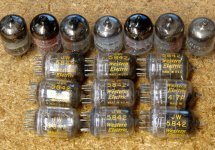 WE5842.jpg130.5 KB · Views: 69
WE5842.jpg130.5 KB · Views: 69 -
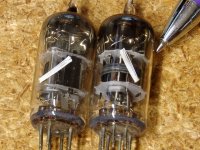 two_of_them.jpg115.9 KB · Views: 68
two_of_them.jpg115.9 KB · Views: 68 -
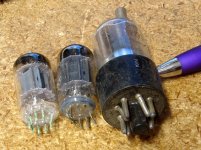 UglyPins.jpg118 KB · Views: 60
UglyPins.jpg118 KB · Views: 60 -
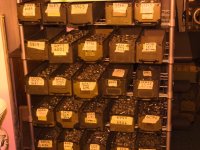 DSC00052_x.jpg266.8 KB · Views: 62
DSC00052_x.jpg266.8 KB · Views: 62 -
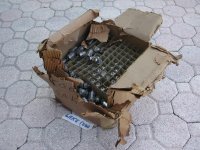 DSCN2370.JPG638.8 KB · Views: 61
DSCN2370.JPG638.8 KB · Views: 61 -
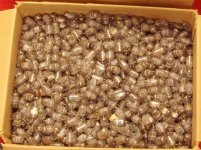 Box_o_tubes.jpg130.9 KB · Views: 65
Box_o_tubes.jpg130.9 KB · Views: 65 -
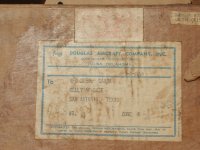 DSCN2373.JPG625.1 KB · Views: 58
DSCN2373.JPG625.1 KB · Views: 58 -
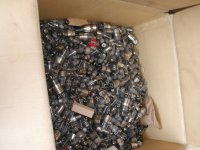 DSCN2507_x.jpg196.6 KB · Views: 60
DSCN2507_x.jpg196.6 KB · Views: 60 -
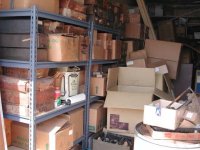 warehouse.jpg54.5 KB · Views: 66
warehouse.jpg54.5 KB · Views: 66
The previous post reveals a little bit of how and why Tubelab got started and why the original Tubelab SE (TSE) amp used a 5842 / WE417A tube for its input stage. I had some pristine WE tubes and a whole box full of Raytheon 5842s. As engineers often do I started making spreadsheets with lists of tubes having compatible pinouts so that I could rig up a way to find out what was useful for audio or RF and what would get sold or trashed. Now, 30 years later I still have 5000 to 10,000 tubes from that lot.
I sorted all the tubes by base type, then by compatible pinouts. Then I rigged up a simple audio gain stage, output stage, or other useful function, connected up some variable power supplies, an audio generator, scope and measurement equipment and tested lots of tubes.
Over the course of several years the spreadsheets got consolidated into one "master chart." I have included it here.
This spreadsheet is mostly concerned with tubes that will PHYSICALLY and ELECTRICALLY FIT a specific socket. The orange colored stripe above a list of tubes depict how the socket must be wired for the tubes immediately below it to function. This does NOT imply that all on the list below can function in the same way, or under the same conditions. In many cases power output tubes and small signal tubes have the same electrical connections.
The term RED BOARD in the 12 pin Duodecar (Compactron) page is Pete Millett's original Engineers Amplifier. With some minor parts placement changes a lot of different tubes will work in that board. Details of these experiments are scattered throughout the long and winding thread. Yes, 250 watts per channel flowed from that board, as did 525 watts of mono. No, every tube on that list will NOT do that!
The Octal Compatibility Matrix lists a lot of tubes that can be used in a board like the UNSET that has jumpers for each pin. Again there is a wide variety of tubes listed with varying power capabilities.
The Tri_Pent page lists two groups of tubes with compatible pinouts. The 9DC, 9AE and other tubes in the top list are all pin compatible with each other. The 9DX tubes in the lower list are all pin compatible with each other. 9DX and the 9AE/9DC tubes do not share a similar pinout. The lists themselves are quite old so that the pricing and inventory is far out of date, as ESRC no longer exists and VacuumTubes.Net has likely changed their prices. I have likely blown up, sold or given away some of my tubes, and maybe even collected some more, so my inventory list is stale too.
I have not added much to these lists in at least 10 years, but I have fixed minor mistakes as I find them. There MAY BE MORE mistakes hidden within, USE AT YOUR OWN RISK......verify proper pinout of any tube on the list before buying them or flipping the power switch.
I sorted all the tubes by base type, then by compatible pinouts. Then I rigged up a simple audio gain stage, output stage, or other useful function, connected up some variable power supplies, an audio generator, scope and measurement equipment and tested lots of tubes.
Over the course of several years the spreadsheets got consolidated into one "master chart." I have included it here.
This spreadsheet is mostly concerned with tubes that will PHYSICALLY and ELECTRICALLY FIT a specific socket. The orange colored stripe above a list of tubes depict how the socket must be wired for the tubes immediately below it to function. This does NOT imply that all on the list below can function in the same way, or under the same conditions. In many cases power output tubes and small signal tubes have the same electrical connections.
The term RED BOARD in the 12 pin Duodecar (Compactron) page is Pete Millett's original Engineers Amplifier. With some minor parts placement changes a lot of different tubes will work in that board. Details of these experiments are scattered throughout the long and winding thread. Yes, 250 watts per channel flowed from that board, as did 525 watts of mono. No, every tube on that list will NOT do that!
The Octal Compatibility Matrix lists a lot of tubes that can be used in a board like the UNSET that has jumpers for each pin. Again there is a wide variety of tubes listed with varying power capabilities.
The Tri_Pent page lists two groups of tubes with compatible pinouts. The 9DC, 9AE and other tubes in the top list are all pin compatible with each other. The 9DX tubes in the lower list are all pin compatible with each other. 9DX and the 9AE/9DC tubes do not share a similar pinout. The lists themselves are quite old so that the pricing and inventory is far out of date, as ESRC no longer exists and VacuumTubes.Net has likely changed their prices. I have likely blown up, sold or given away some of my tubes, and maybe even collected some more, so my inventory list is stale too.
I have not added much to these lists in at least 10 years, but I have fixed minor mistakes as I find them. There MAY BE MORE mistakes hidden within, USE AT YOUR OWN RISK......verify proper pinout of any tube on the list before buying them or flipping the power switch.
Attachments
Last edited:
- Home
- Amplifiers
- Tubes / Valves
- 6KT8 pin-out - pentode G3 tied to heater